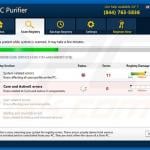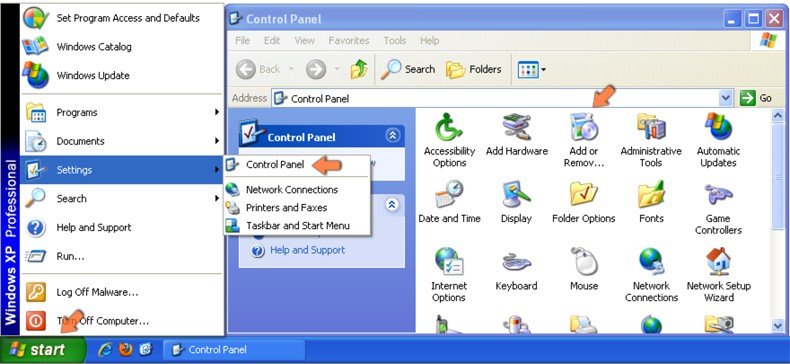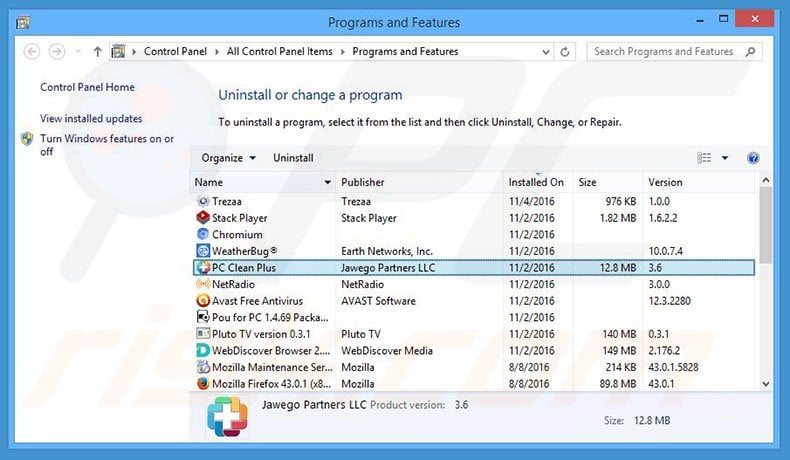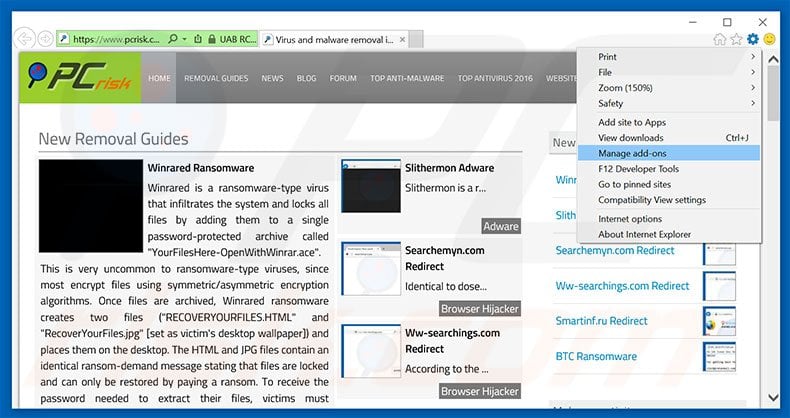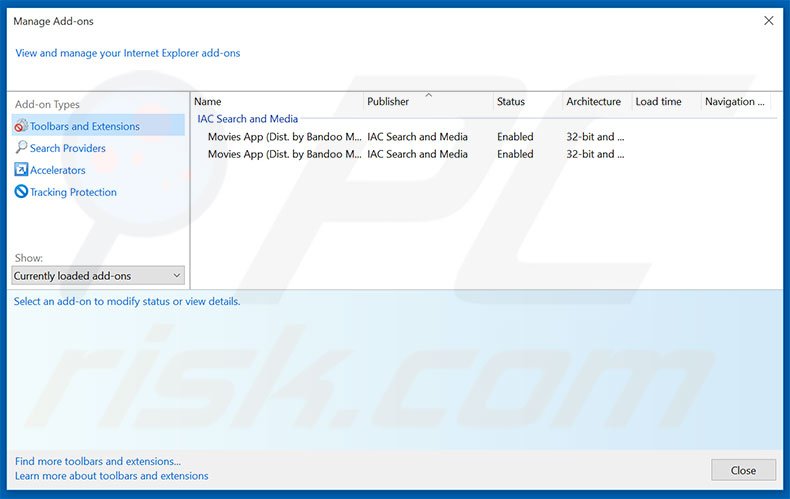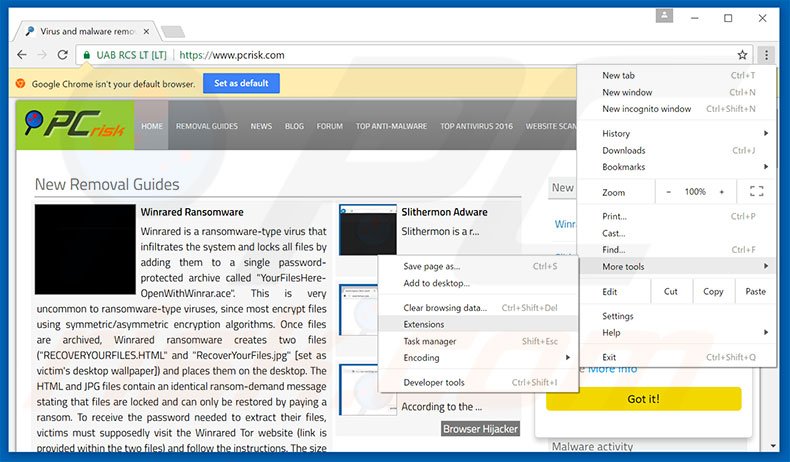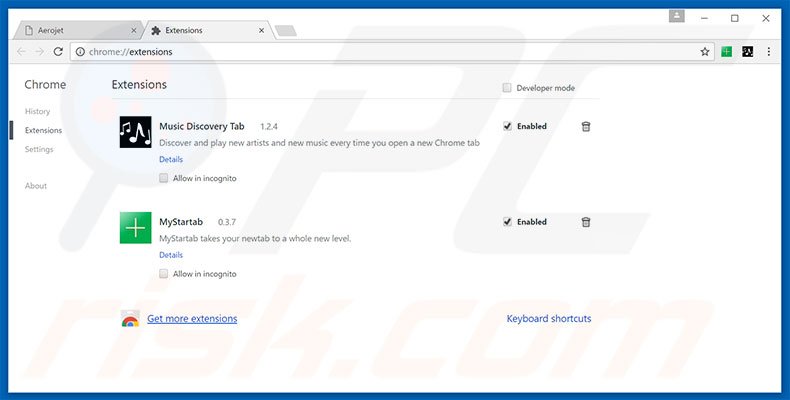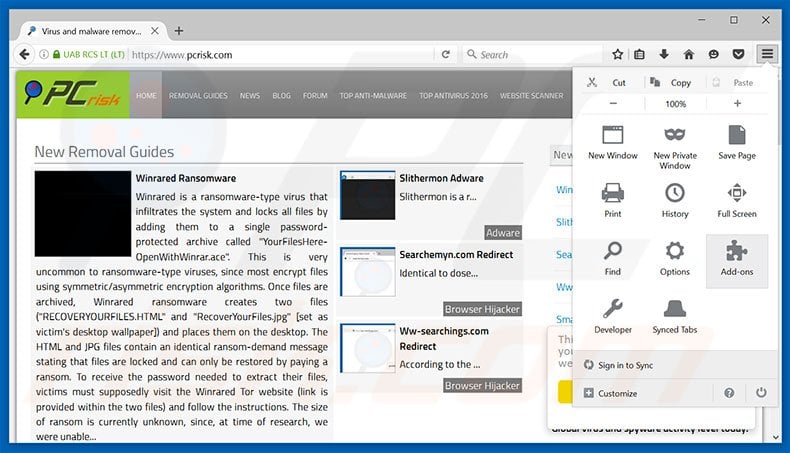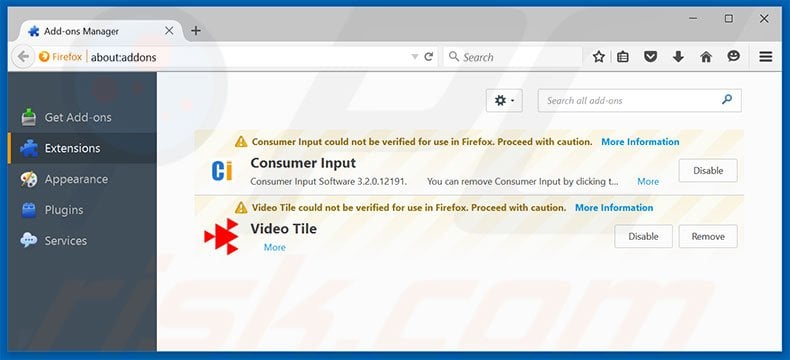Вирус warning your computer may be at risk call 8447635838
Что такое Warning Call (844) 763-5838?
Если Warning Call (844) 763-5838 всплывающие в браузере появляется каждый раз, когда вы открываете их, это означает, что у вас есть потенциально нежелательные программы на вашем компьютере. Приложение отвечает за это поддельные объявления отвечает также за другие нежелательные действия, которые вы уже заметили. Следует избегать взаимодействия с предупреждением, потому что это совершенно ненадежными. Если вы хотите избавиться от Warning Call (844) 763-5838, вам придется прекратить Warning Call (844) 763-5838 соответствующие программы.
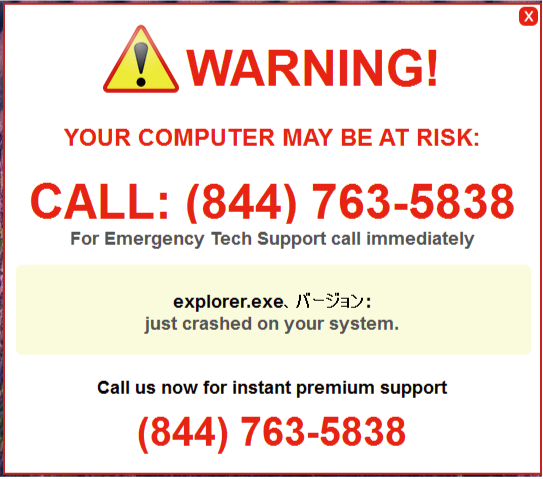
Как работает Warning Call (844) 763-5838?
Warning Call (844) 763-5838 всплывающих нет ничего но афера. Он утверждает, что ваш компьютер находится под угрозой и что для ее устранения необходимо вызвать предоставленный номер. Предположительно это номер технической поддержки, и если вы называете это, квалифицированные специалисты помогут вам с вашей проблемой. Правда, номер принадлежит кибер-преступников, которые будут пытаться получить ваши личные данные и продать вам поддельные продукты. Падение для этого мошенничества может привести не только в вас раскрывать ваши личные данные для ненадежных источников и потерять свои деньги, но и в вас заразить ваш компьютер с вредоносными программами.
Это мошенничество связано с Secure PC Cleaner, который классифицируется как потенциально нежелательные программы. Предполагается, что для очистки реестра из существующих ошибок. В действительности однако, он не делает ничего, но подскажут вам поддельные оповещения в попытке убедить вас купить ее полную версию. Вы не должны тратить деньги на это заблуждение кусок программного обеспечения. Вместо этого вы должны избавиться от него и таким образом устранить Warning Call (844) 763-5838 оповещения для хорошего.
Как удалить Warning Call (844) 763-5838?
Как мы уже упоминали, для того чтобы удалить Warning Call (844) 763-5838 всплывающих окон, вам придется удалить потенциально нежелательные программы, ответственных за них. Есть два варианта, вы можете выбрать из: ручной или автоматический Warning Call (844) 763-5838 удаления. Мы советуем, что вы идете с автоматической Warning Call (844) 763-5838 удаления, потому что это весьма вероятно, что у вас есть несколько нежелательных программ на вашем компьютере. Если вы используете anti-malware с нашего сайта, это будет сканировать вашу систему и обнаруживать все потенциальные угрозы. Это будет очистить ваш компьютер от всех них и держать его защищены от других онлайн инфекций, двигаться вперед. Если, с другой стороны, вы решили пойти с вариантом ручного удаления, просто удалив нежелательные приложения может оказаться недостаточно. Для того, чтобы полностью устранить безопасный PC Cleaner, необходимо выполните следующие действия:
- Нажмите Win + E, чтобы открыть проводник
- Введите % APPDATA % в адресную строку и нажмите клавишу Enter
- Удаление монитора событий папки
- Нажмите Win + R чтобы открыть Run
- Перейти к HKEY_CURRENT_USERSOFTWAREWow6432Node (или HKEY_LOCAL_MACHINESOFTWAREWow6432Node)
- Удалить монитор событий
- Перейти к HKEY_CURRENT_USERSOFTWARE (или HKEY_LOCAL_MACHINESOFTWARE)
- Удаление монитора событий ключа
- Перезагрузите систему
Скачать утилиту to scan for Warning Call (844) 763-5838 Use our recommended removal tool to scan for Warning Call (844) 763-5838. Trial version of WiperSoft provides detection of computer threats like Warning Call (844) 763-5838 and assists in its removal for FREE. You can delete detected registry entries, files and processes yourself or purchase a full version.
More information about WiperSoft and Uninstall Instructions. Please review WiperSoft EULA and Privacy Policy. WiperSoft scanner is free. If it detects a malware, purchase its full version to remove it.

WiperSoft обзор детали WiperSoft является инструментом безопасности, который обеспечивает безопасности в реальном в .
Это MacKeeper вирус?MacKeeper это не вирус, и это не афера. Хотя существуют различные мнения о программе в Интернете, мн .
Хотя создатели антивирусной программы MalwareBytes еще не долго занимаются этим бизнесом, они восполняют этот нед� .
The article is only meant to be used for educational purposes. If you follow the instructions given in the article, you agree to be contracted by the disclaimer. We do not guarantee that the artcile will present you with a solution that removes the malign threats completely. Malware changes constantly, which is why, in some cases, it may be difficult to clean the computer fully by using only the manual removal instructions.

Что это за вирус, как его удалить?
Каждый компьютер приносит пользу человеку. Кто-то находит в нём средство заработка денег. Кто-то — предмет, который помогает убить время.
Сегодня мы поговорим о том, почему компьютеры хороши и какие у них есть минусы. Самый большой минус — вирус. И вот бывает так, что приходя домой вы хотите посмотреть любимый фильм, но…
Давайте постараемся разобраться в проблеме и решить её, как можно быстрее.
Баннер не самый простой. Закрыв его от него нереально избавиться. Нужно ещё и ещё закрывать, пока он не пропадёт и вовсе. И то, через время он вновь появится, как назойливый жук. Есть такое решение проблемы — перезагрузка компьютера.
Но давайте будем честными — в этом случае она не поможет ни коем образом. Нам понадобятся две программы — AdwCleaner и CCleaner. Одна программа проверяет и удаляет файлы. Другая делает то же самое, только с более уплотнённой проверкой каждого файла.
Нужно закрыть все программы, которые только есть на компьютере. Это нужно для того, чтобы вирус было проще найти. Да и меньше памяти будет обрабатываться при использовании очистки. Помните, что на компьютере должны быть только те программы, которые были установлены лично Вами.
После этого нужно зайти в такую папку, как Temp и удалить всё содержимое из неё. Да, именно удалить всё, что в ней есть. Находится она по пути C:\ Users\ Администратор\ AppData\ Local\ Temp. Без этого никак. Удаляем абсолютно всё, чтобы больше не беспокоиться об этой программе и радуемся результату.
После удаления запускаем AdwCleaner и хорошенько всё проверяем. Он найдёт ненужные файлы, разберётся с ними и найдёт выход из ситуации. Предупреждаем, что одна проверка может не выявить вирус, так что старайтесь делать их несколько.
Только так Вы сможете найти ненужные файлы, которые затаились. После всего этого вступает в действие CCleaner.
Она будет чистить все оставшиеся файлы, которые прошлая программа отыскать не сумела. Частенько бывает так, что сам вирус залезает именно в браузер. Так что эти две программы помогут справиться с проблемой по-быстрому.
Если вирус уже сидит в браузере — нужно его сбросить, возможно и удалить с папкой, потому что он может быть расположен именно там. После удаления всё будет в порядке и вируса больше не будет.
Также, рекомендуется использоваться антивирус, который легко находит мелкие вирусы и избавляет компьютер от них. Лучшие из них — Avast, Kaspersky, Dr. Web и так далее. Это наиболее популярные антивирусы, которые легко справятся с подобной проблемой.
Если уж и это не помогло Вам, то вирус действительно засел очень глубоко и стоит обратиться к настоящему мастеру. Он проверит компьютер с ног до головы. В случае, когда он не найдёт решение выход останется только один — переустанавливать Windows.
На этом наша статья подходит к своему завершению. Мы рады, что сумели Вам помочь и что Вы дочитали нашу статью до конца. Проблема легко решается, если правильно расписывать решение к ней. Конечно, может показаться сложным процесс удаления вируса, но… На самом то деле это не так.
Это очень просто, главное, чтобы у человека было желание решать проблему, а не ждать, когда она исчезнет. Помните, что все вирусы всегда ищут только пользу. Кому-то вирус нужен, чтобы контролировать страницу и знать пароли. Для кого-то вирус — чистый заработок, как в случае с майнером, приносящим хакеру деньги.
Ни один вирус не будет работать просто так, уж так принято. Да и не каждый антивирус может найти вирусы, которые глубоко расположены в системе. Они чаще всего блокируют все возможные функции компьютера, из-за чего тот начинает тормозить и выдавать различные ошибки.
Мы желаем Вам в дальнейшем не сталкиваться с проблемами такого рода, ведь нет уверенности, что Вы сумеете решить проблему.
Hello, today i noticed a pop up on my parents PC when i tried to run malwarebytes. I did some research on it and i found its a Tech Scam Trojan. Process name is sm.exe and its disguised as a System Monitor. I tried Avast, HitmanPro and AVG but none of it found it. I heard that it writes some key in Registry but idk how to fix it. Here's a image of the pop-up.:
Edited by MarkusCZ, 02 June 2017 - 10:24 AM.
![]()
- BleepingComputer.com
- Register to remove ads
malwarebytes anti malware
in that order. run them
whatever you do. do not call.
To Insanity and Beyond

- Gender: Male
- Location: NJ USA
- Local time: 04:48 PM
Hi, I moved you from XP to here, Am I Infected.
Please run the Panda Cloud Cleaner
malwarebytes anti malware
in that order. run them
whatever you do. do not call.
Thanks soo much the ADWcleaner removed it all even with the registry keys

- Gender: Male
- Location: Virginia, USA
- Local time: 04:48 PM
Tech Support Scamming through unsolicited phone calls, browser pop-ups and emails from "so-called Support Techs" advising "your computer is infected with malware", All Your Files Are Encrypted" and other fake "alert messages" has become an increasing common scam tactic over the past several years. The scams may involve web pages with screenshots of fake Microsoft (Windows) Support messages, fake reports of suspicious activity, fake warnings of malware found on your computer, fake ransomware and fake BSODs all of which include a tech support phone number to call in order to fix the problem. If you call the phone number (or they called you), scammers will talk their victims into allowing them remote control access of the computer so they can install a Remote Access Trojan in order to steal passwords and other sensitive personal information which could then be used to access bank accounts or steal a person's identity.
Not answering any questions and hanging up the telephone is the best way to deal with phone scammers. then report them to the appropriate authorities.
If you are dealing with browser pop-up scams, closing the web browser and then relaunching it usually eliminates the bogus warning message and is the best way to deal with these scams. If the browser freezes or hangs, you may have to close it with Windows Task Manager by selecting End Task.
Scammers and cyber-criminals are very innovated. see Tech Support Scams use new Tricks to Hold Browsers Hostage . They are always developing creative and more sophisticated techniques to snare their victims into providing personal information or stealing their money for financial gain. The criminals can target specific browsers like Microsoft Edge, Google Chrome, specific devices like Apple and even your iPhone or iPad.
- Microsoft Edge. Can Be Abused for Tech Support Scams
- Tech support scams and Google Chrome tricks
- Scammers target Apple customers
- Fake iOS Crash Reports hijack your iPhone or iPad

Written by Tomas Meskauskas on 21 August 2017 (updated)
Your Computer May Be At Risk removal instructions
"Your Computer May Be At Risk" is a fake error message displayed by a number of deceptive potentially unwanted programs (PUPs, such as "PC Clean Plus", "PC Purifier", etc.) By offering a variety of 'useful features', PUPs often trick users into believing that they are legitimate programs. In fact, they often infiltrate systems without consent. Furthermore, these rogue programs track web browsing activity and often display intrusive online advertisements.
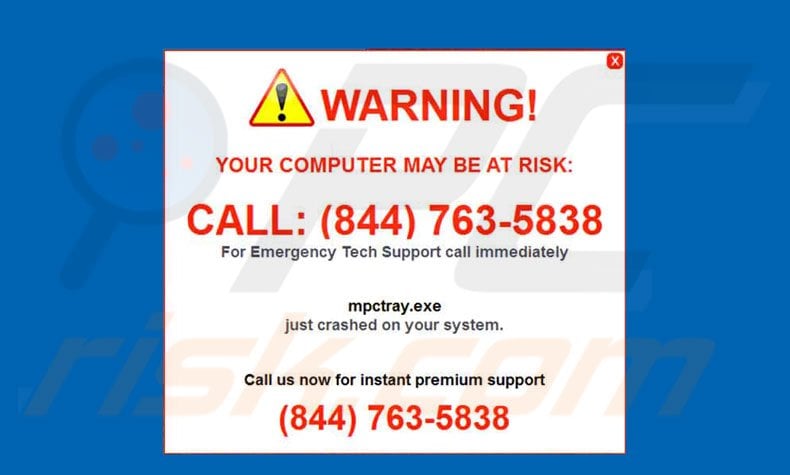
The "Your Computer May Be At Risk" error states that the system has crashed. To receive help in solving this problem, users must supposedly contact "Tech Support" via a telephone number provided (844-763-5838). Be aware, however, that this error message is not genuine - it is a scam. Criminals merely attempt to trick victims into calling and paying for services that are not required. Furthermore, PUPs often gather information such as IP addresses, URLs visited, pages viewed, search queries, etc., without users' consent. This recorded data might be personally identifiable and shared by developers of PUPs with third parties (potentially, cyber criminals) who generate revenue by misusing personal information. Thus, the presence of information-tracking applications on your system can lead to serious privacy issues or even identity theft. Another downside is display of intrusive online advertisements. Pop-up, banner, coupon, and other similar ads are displayed using a ‘virtual layer’ (a tool that enables placement of third party graphical content on any site). These ads often conceal underlying web content and can lead to malicious websites - even accidental clicks might result in high-risk adware or malware infections. For these reasons, uninstall potentially unwanted programs immediately.
| Name | Your Computer May Be At Risk virus |
| Threat Type | Adware, Unwanted ads, Pop-up Virus |
| Symptoms | Seeing advertisements not originating from the sites you are browsing. Intrusive pop-up ads. Decreased Internet browsing speed. |
| Distribution methods | Deceptive pop-up ads, free software installers (bundling), fake flash player installers. |
| Damage | Decreased computer performance, browser tracking - privacy issues, possible additional malware infections. |
| Malware Removal (Windows) |




